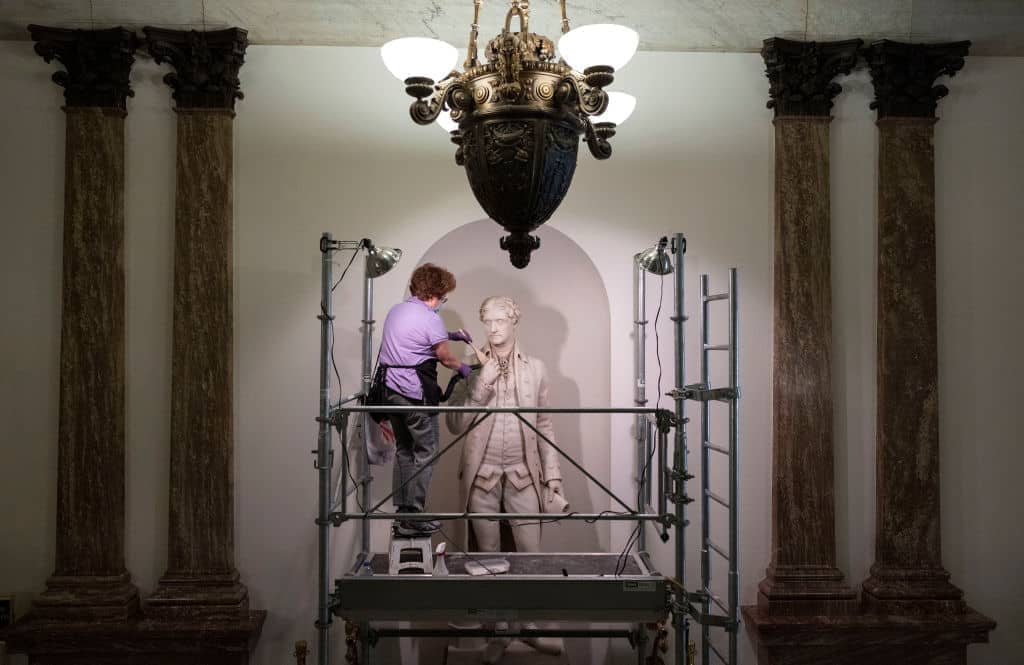A victim of revolution, King George III’s statue was toppled almost 250 years ago in New York. Now the statue of his most bitter critic, Thomas Jefferson, is to follow in his footsteps – after the founding father’s likeness was removed from New York City Hall this week because he was a slave owner.
Jefferson’s statue will be moved down the road to the New York Historical Society, after the city’s public design commission unanimously voted to remove him from his plinth. His statue had been in the city council chamber since 1915, but as councilwoman Adrienne Adams explained in a presentation:
‘It makes me deeply uncomfortable knowing that we sit in the presence of a statue that pays homage to a slaveholder who fundamentally believed that people who look like me were inherently inferior, lacked intelligence, and were not worthy of freedom or right.’
There is not only a false past on offer but also a contentious present and a malign future
Jefferson was not only the writer of the Declaration of Independence, and a major figure in Virginia’s war, but also a two-term President and ambassador to France. But he is to be a non-person. The mark of Cain is slavery, and that is enough to precipitate his fall.
The history wars currently taking place in America are vigorous, and in some respects longer lasting than those in Britain. The absence of the British monarchy, which provides a basic harmony, has been absent from American life since the mid-eighteenth century. The United States is still digesting in its public history and its more recent civil war – as well as confronting every four years the issues bound up in the election of a head of state.
These elections make the reputation of past presidents particularly contentious, and Jefferson attracts ire from those seeking to direct attention against the national origin-account.
Slavery has been weaponised not so much in a conflict between left and right (although it plays a role in that battle) as in the fight between progressives and those on the softer left. Pushing the left even further leftwards offers possibilities for power, or at least influence, to politicians and commentators who wish to direct the Democratic party and thereby gain control of the state. This is even more attractive as government powers have expanded in the age of Covid.
The recent spate of attacks on statues – with protestors also pulling down a monument to Jefferson during the Black Lives Matter protests last year – are simply the most obvious, and visual, example of a more wide-ranging process designed to banish America’s established sense of historical identity. It is a process that has targeted everything from school curricula to street names, in a manner comparable to the ‘Cultural Revolutions’ attempted from China and Cambodia to campuses across the West in the 1960s.
In the case of America, history is understandably at the forefront of this battle, because America, unlike all other major states, has an historic constitution that is essential to its founding myth. This makes the intentions and contexts of the Founding Fathers particularly contentious today.
The assault on America’s founding history was focused by the 1619 Project, launched by the New York Times in 2019, which intended to ‘reframe the country’s history by placing the consequences of slavery and the contributions of Black Americans at the very centre of the United States’ national narrative.’
The contentious accuracy of some of the 1619 Project’s claims (for example, the unfounded assertion that the American colonists sought independence to protect the practice of slavery) are beside the point. The intention of the project was to assert a new ‘truth’ that condemns modern America due to the legacy of slavery. This condemnation relies on both trashing the established narrative of the American Revolution, and the downplaying of the significance of later white men such as Abraham Lincoln and those associated with the struggle for civil rights.
This struggle against the idea of America is linked to the rise of critical race theory – a developing movement made up of half-baked anachronisms, poor scholarship, and rampant conspiracy theories. There is not only a false past on offer but also a contentious present and a malign future. Critics of this narrative seek out division in both past and present as a background to continuous revolution in the future.
For British observers, it is troubling to see our great ally disseminate this kind of hate against the great men of history. Kamala Harris might think the 1619 Project ‘a powerful and necessary reckoning of our history.’ In practice, it is divisive and destructive. Jefferson’s statue will not be the last of its victims.
Jeremy Black’s recent books include short histories of both war and France as well as The Importance of Being Poirot and England in the Age of Dickens.






Comments